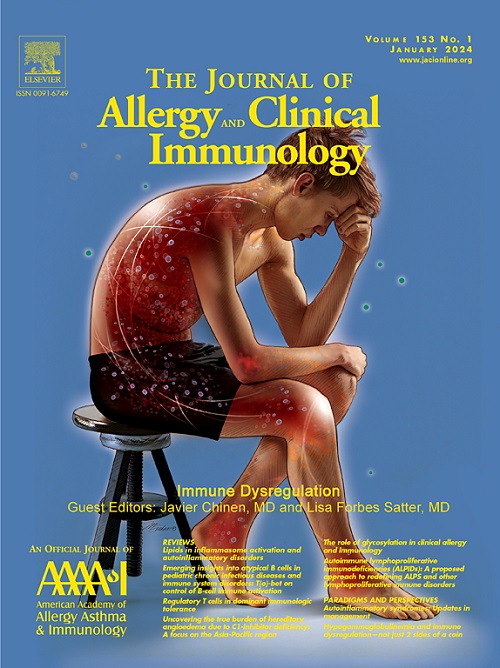战胜人类FOXN1变异的临床决策。
IF 11.2
1区 医学
Q1 ALLERGY
引用次数: 0
摘要
胸腺T细胞的发育是由胸腺上皮细胞(TECs)协调的。TECs的主要转录调控因子是叉头盒N1 (FOXN1),它控制TECs的分化、扩展和功能。FOXN1的双等位基因奠基者突变导致先天性胸腺发育不全和秃发导致裸/严重联合免疫缺陷(SCID)表型。这证实了FOXN1在皮肤和指甲的tec和上皮细胞中的关键作用。新生儿通过T细胞受体切除环(TREC)检测以及外显子组和基因组测序筛查严重T细胞缺乏症的出现,导致FOXN1变异的数量急剧增加。FOXN1变异的影响范围从致病到良性不等。然而,大多数FOXN1突变被列为意义未知的变异。在单等位基因FOXN1变异中,有一些作为显性阴性,导致短暂的T细胞淋巴细胞减少。在这篇综述中,不同FOXN1变异的临床影响是根据突变的类型和位置进行分类的。了解这些FOXN1突变如何影响蛋白质功能有助于临床护理;实验室监测,预防措施,和同种异体胸腺植入的决定。本综述提供了FOXN1的关键功能见解,从而实现更好的临床护理。本文章由计算机程序翻译,如有差异,请以英文原文为准。
Informed clinical decisions by outfoxing human FOXN1 variants
Thymic T-cell development is orchestrated by thymic epithelial cells. The master transcriptional regulator of these cells is forkhead box N1 (FOXN1), which controls their differentiation, expansion, and function. Biallelic founder mutations in FOXN1 caused a nude/severe combined immunodeficiency phenotype due to congenital thymic aplasia and alopecia universalis. This established the critical role of FOXN1 in thymic epithelial cells and epithelial cells in the skin and nails. The emergence of newborn screening for severe T-cell deficiency via the T-cell receptor excision circle assay, along with exome and genome sequencing, has led to dramatic increases in the number of FOXN1 variants identified. The consequent impact of the FOXN1 variants ranges from pathogenic to benign, yet most FOXN1 mutations are listed as variants of unknown significance. Among monoallelic FOXN1 variants are some that act as dominant negative, resulting in a transient T-cell lymphopenia. In this review, the clinical impacts of diverse FOXN1 variants are categorized by mutation type and location. Knowing how these FOXN1 mutations affect protein function informs clinical care as well as laboratory monitoring, prophylactic measures, and allogeneic thymic implant decisions. This review provides key functional insights into FOXN1, enabling better clinical care.
求助全文
通过发布文献求助,成功后即可免费获取论文全文。
去求助
来源期刊
CiteScore
25.90
自引率
7.70%
发文量
1302
审稿时长
38 days
期刊介绍:
The Journal of Allergy and Clinical Immunology is a prestigious publication that features groundbreaking research in the fields of Allergy, Asthma, and Immunology. This influential journal publishes high-impact research papers that explore various topics, including asthma, food allergy, allergic rhinitis, atopic dermatitis, primary immune deficiencies, occupational and environmental allergy, and other allergic and immunologic diseases. The articles not only report on clinical trials and mechanistic studies but also provide insights into novel therapies, underlying mechanisms, and important discoveries that contribute to our understanding of these diseases. By sharing this valuable information, the journal aims to enhance the diagnosis and management of patients in the future.

 求助内容:
求助内容: 应助结果提醒方式:
应助结果提醒方式:


